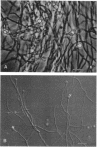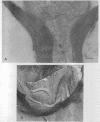Abstract
Frankia strains are N2-fixing actinomycetes whose isolation and cultivation were first reported in 1978. They induce N2-fixing root nodules on diverse nonleguminous (actinorhizal) plants that are important in ecological successions and in land reclamation and remediation. The genus Frankia encompasses a diverse group of soil actinomycetes that have in common the formation of multilocular sporangia, filamentous growth, and nitrogenase-containing vesicles enveloped in multilaminated lipid envelopes. The relatively constant morphology of vesicles in culture is modified by plant interactions in symbiosis to give a diverse array of vesicles shapes. Recent studies of the genetics and molecular genetics of these organisms have begun to provide new insights into higher-plant-bacterium interactions that lead to productive N2-fixing symbioses. Sufficient information about the relationship of Frankia strains to other bacteria, and to each other, is now available to warrant the creation of some species based on phenotypic and genetic criteria.
Full text
PDF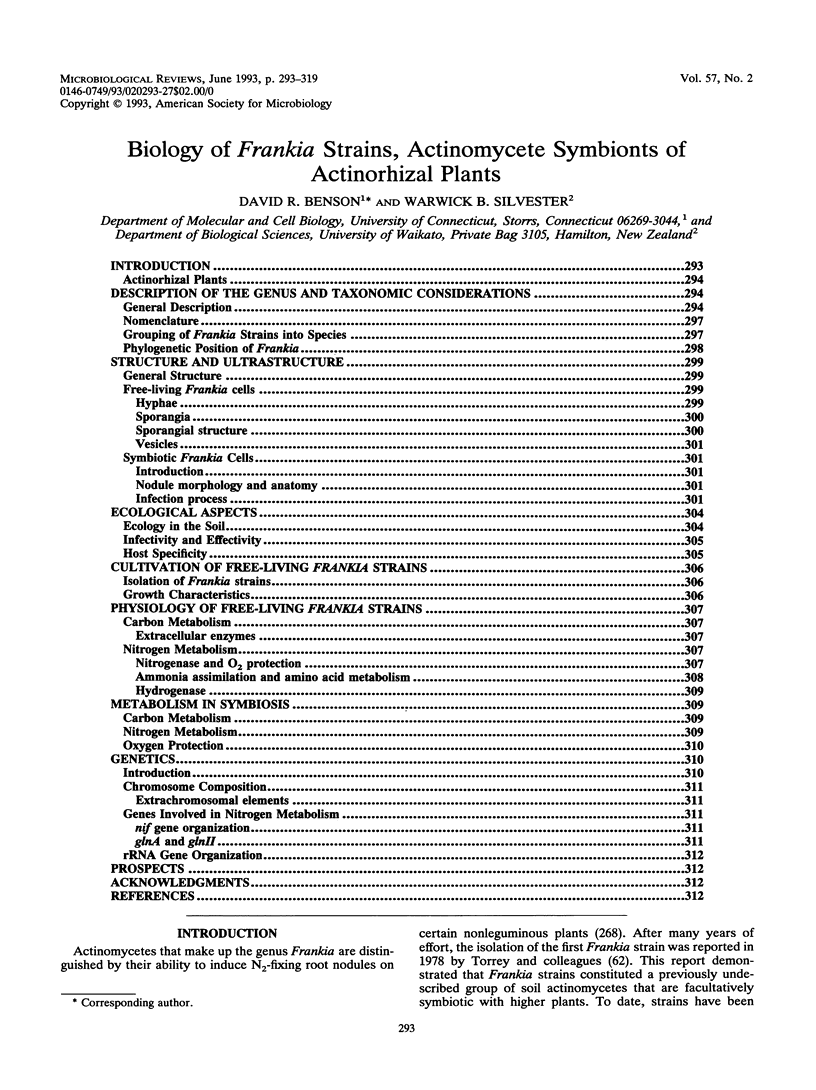
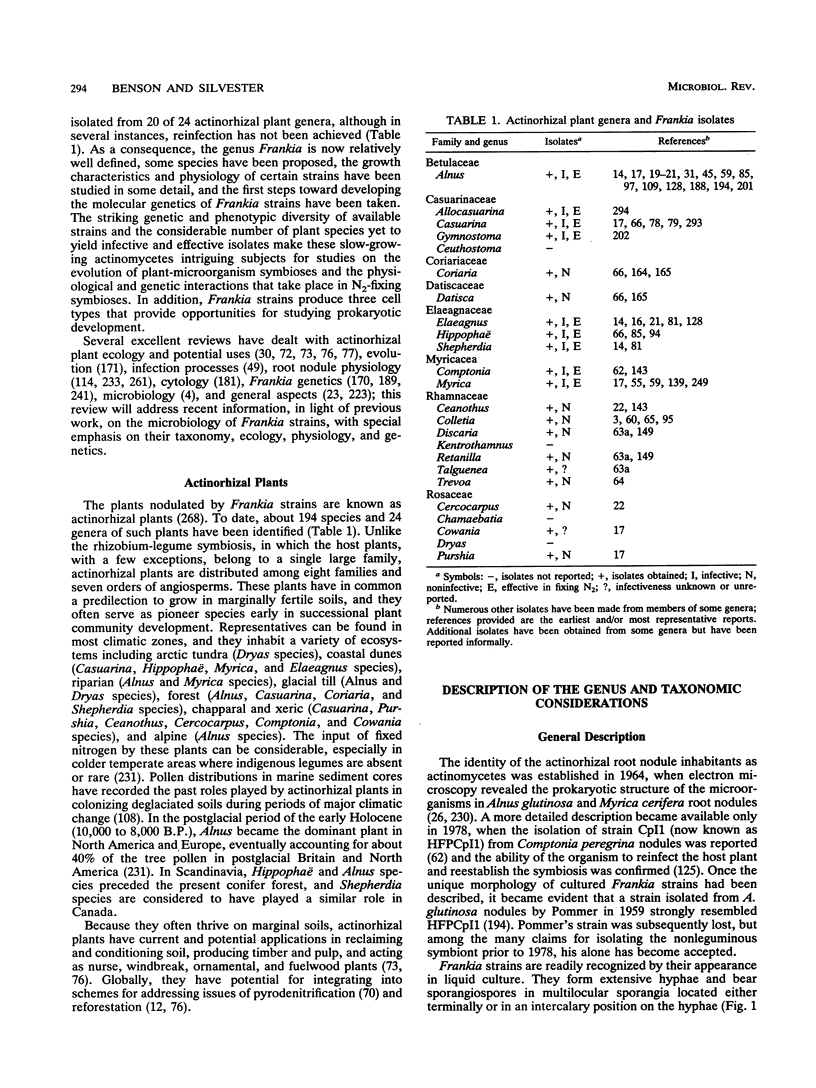

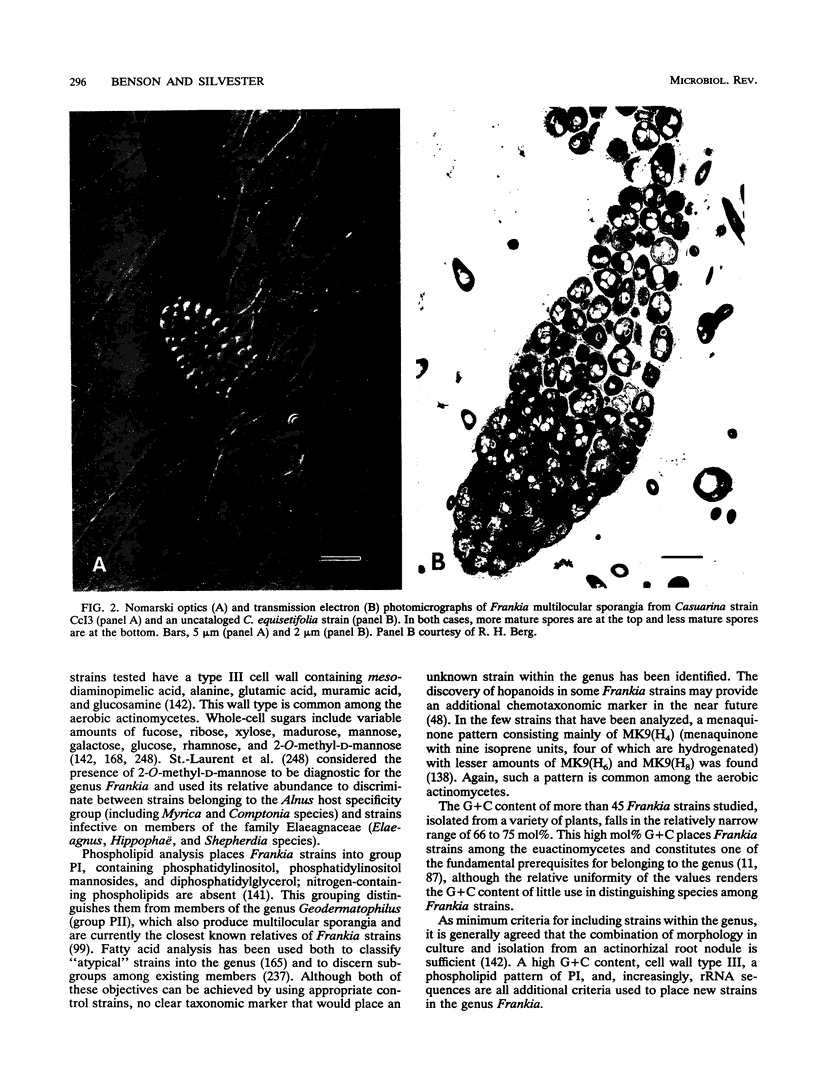
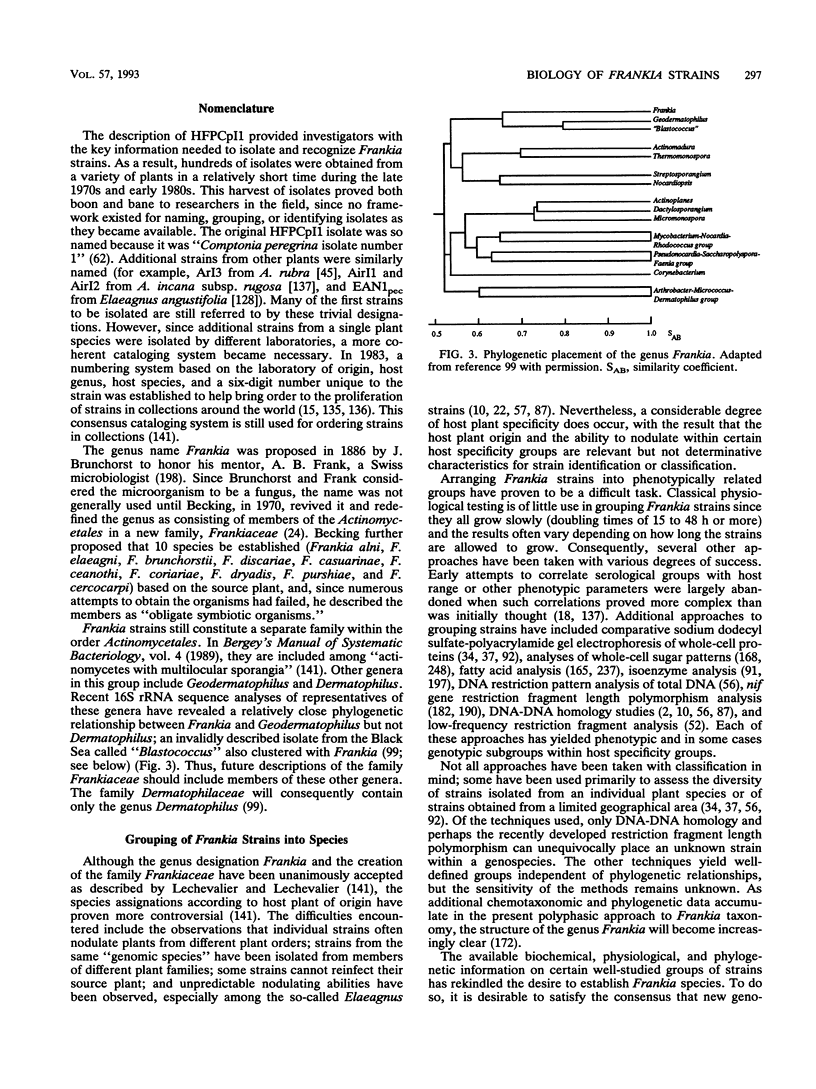
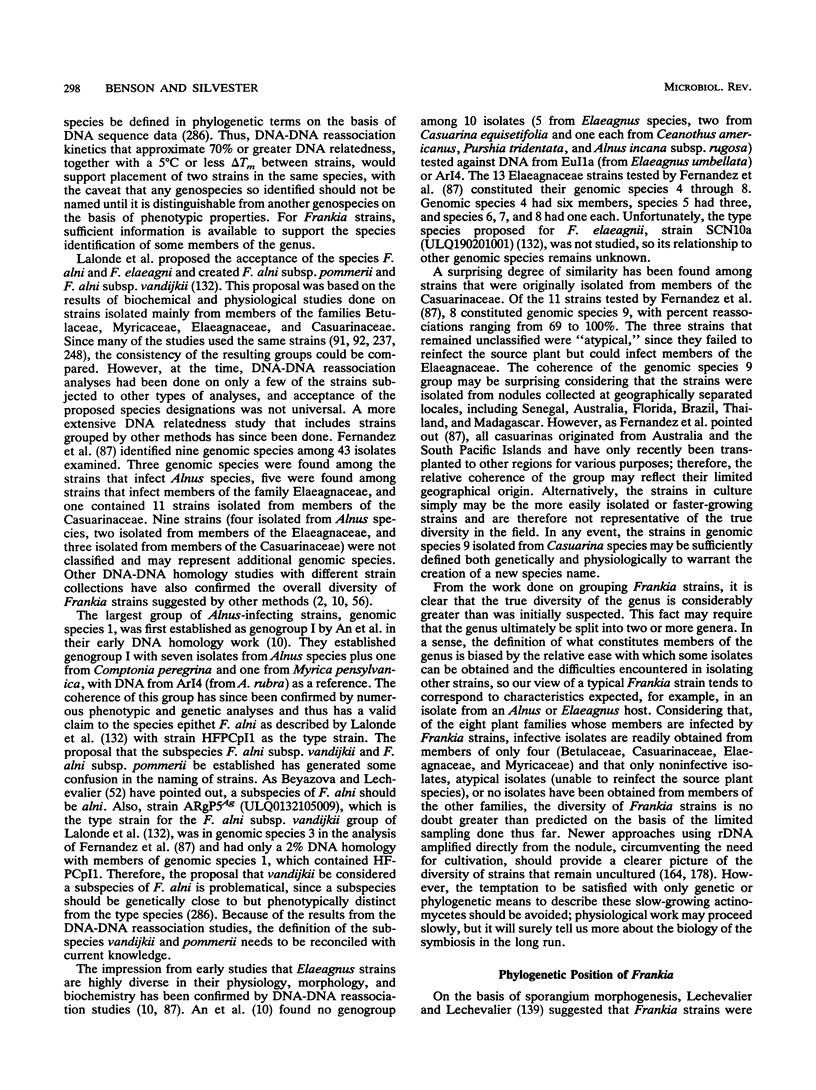
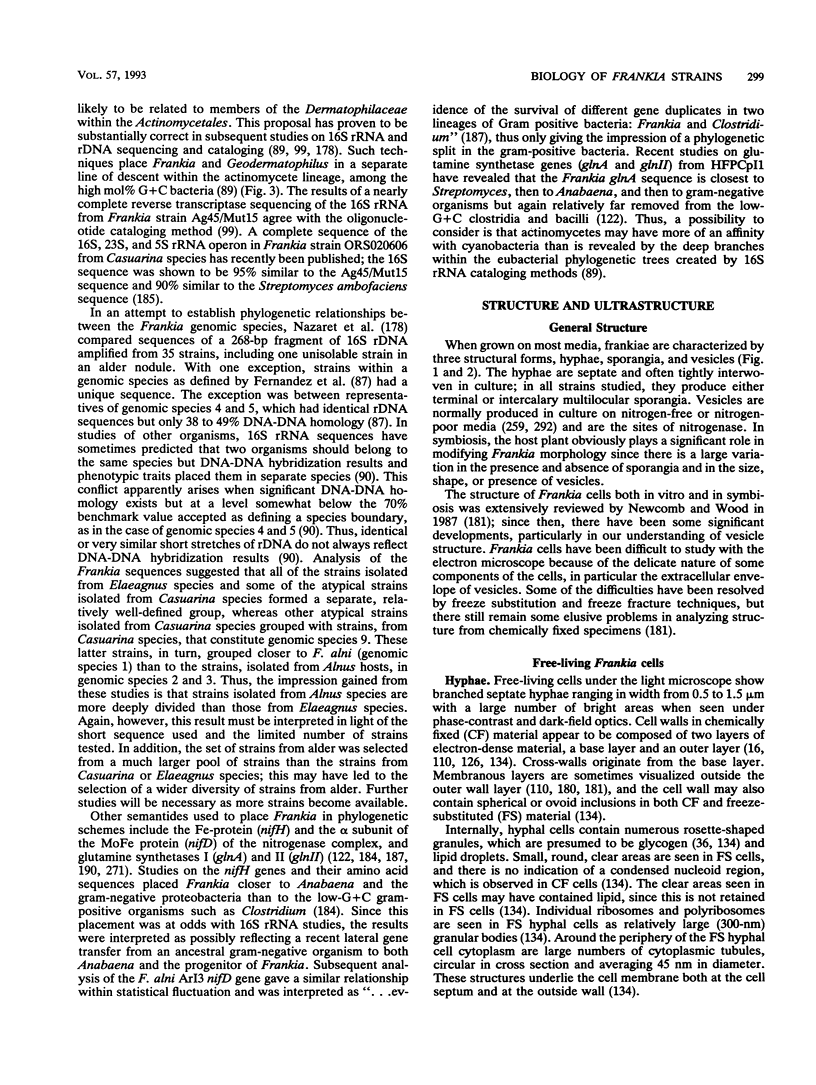
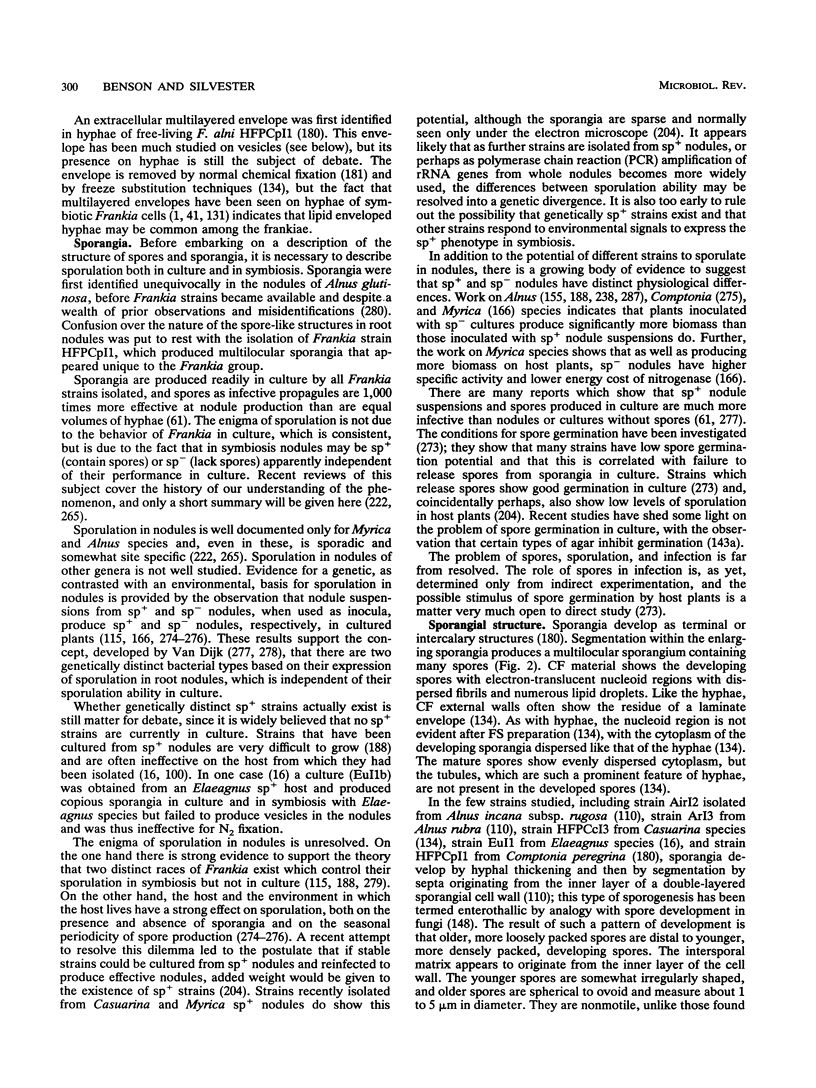
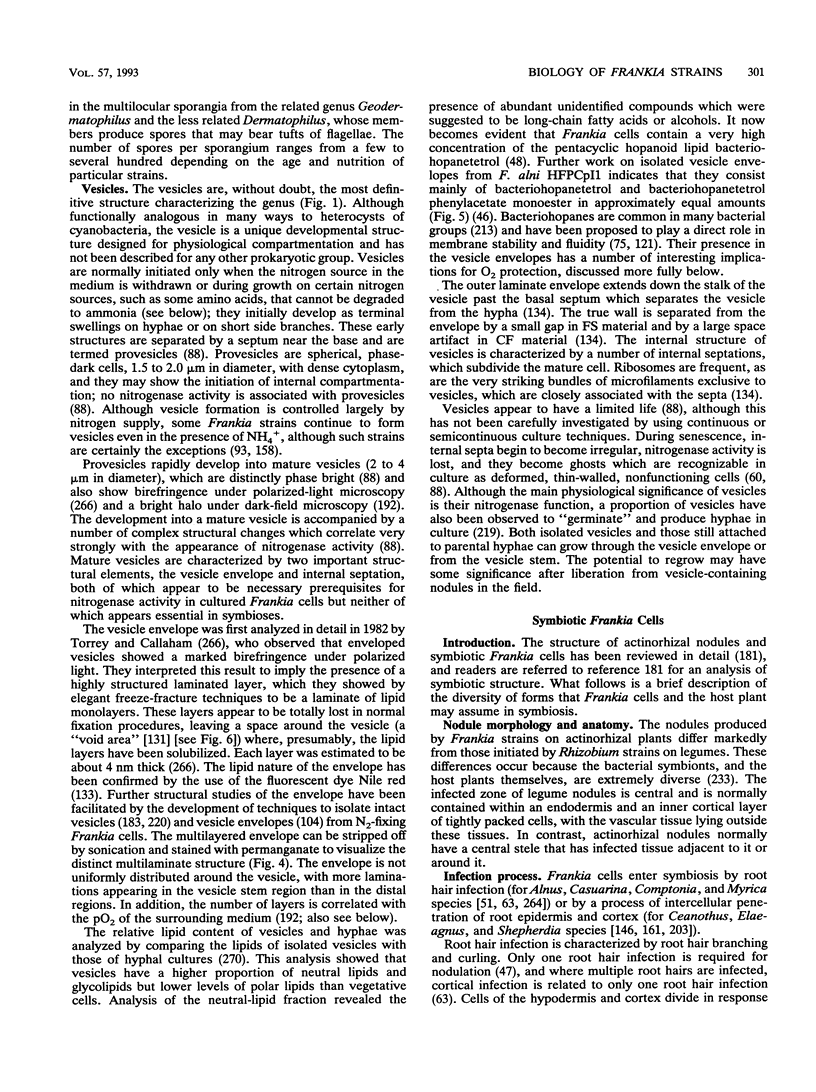
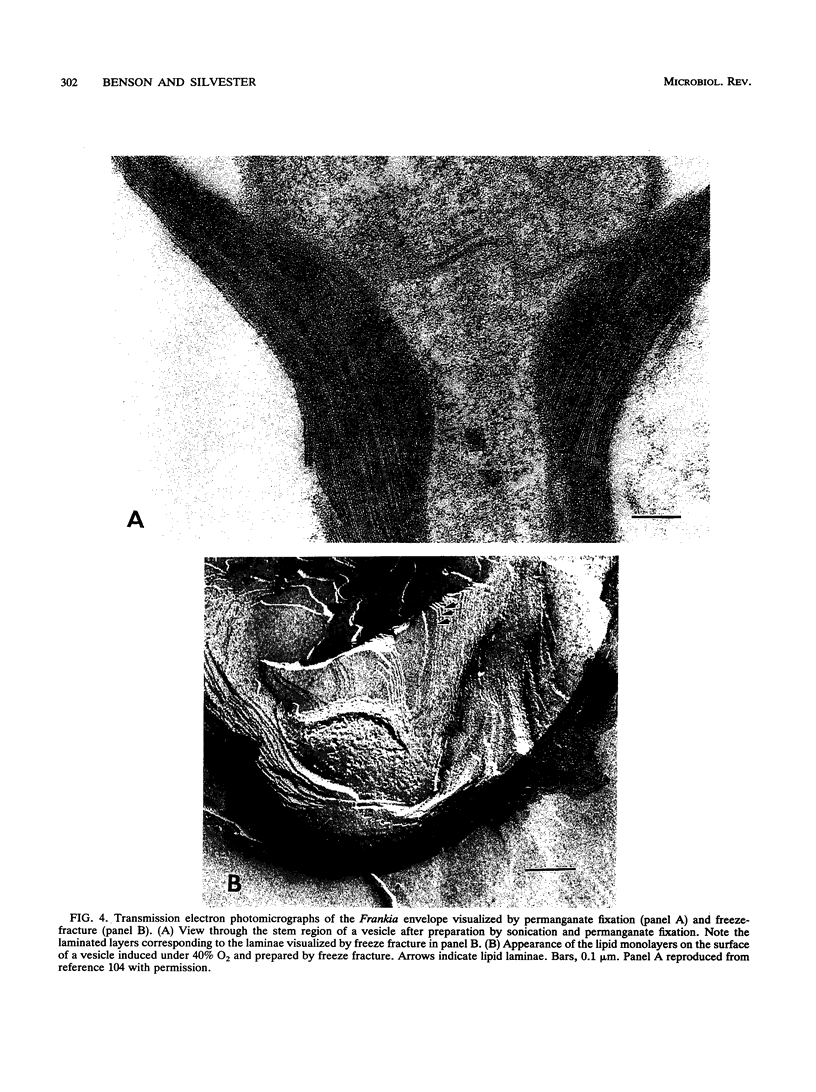
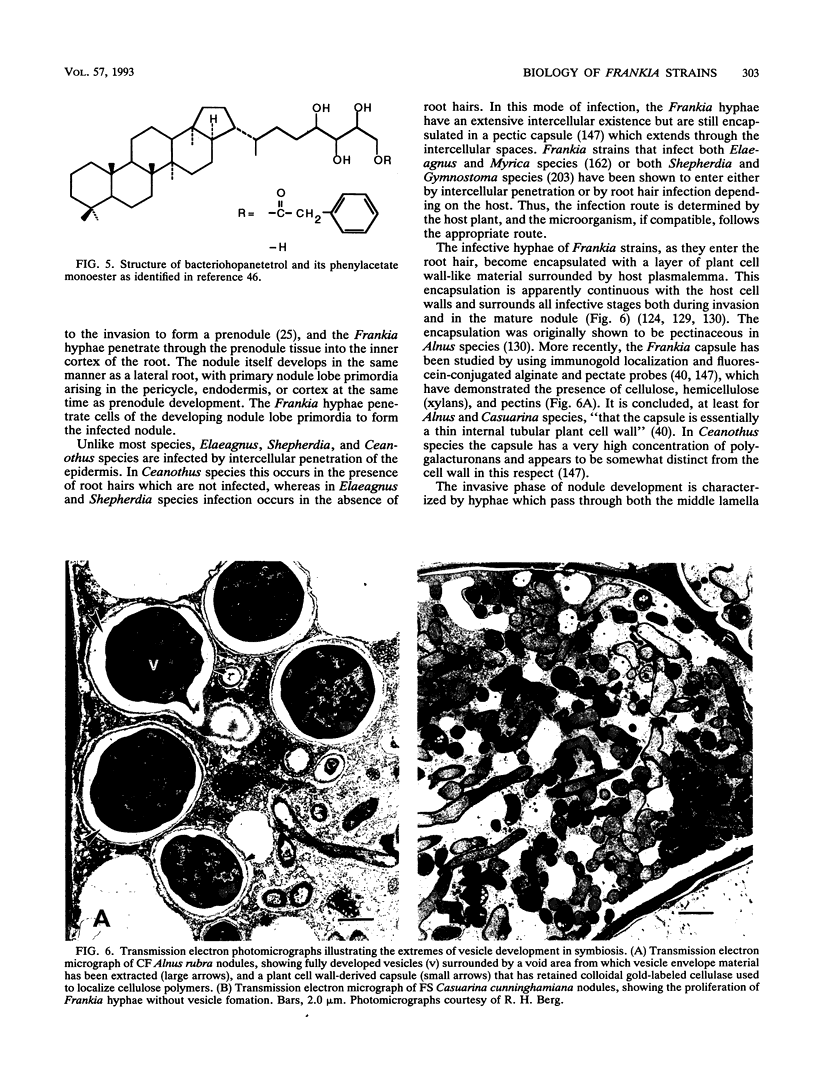
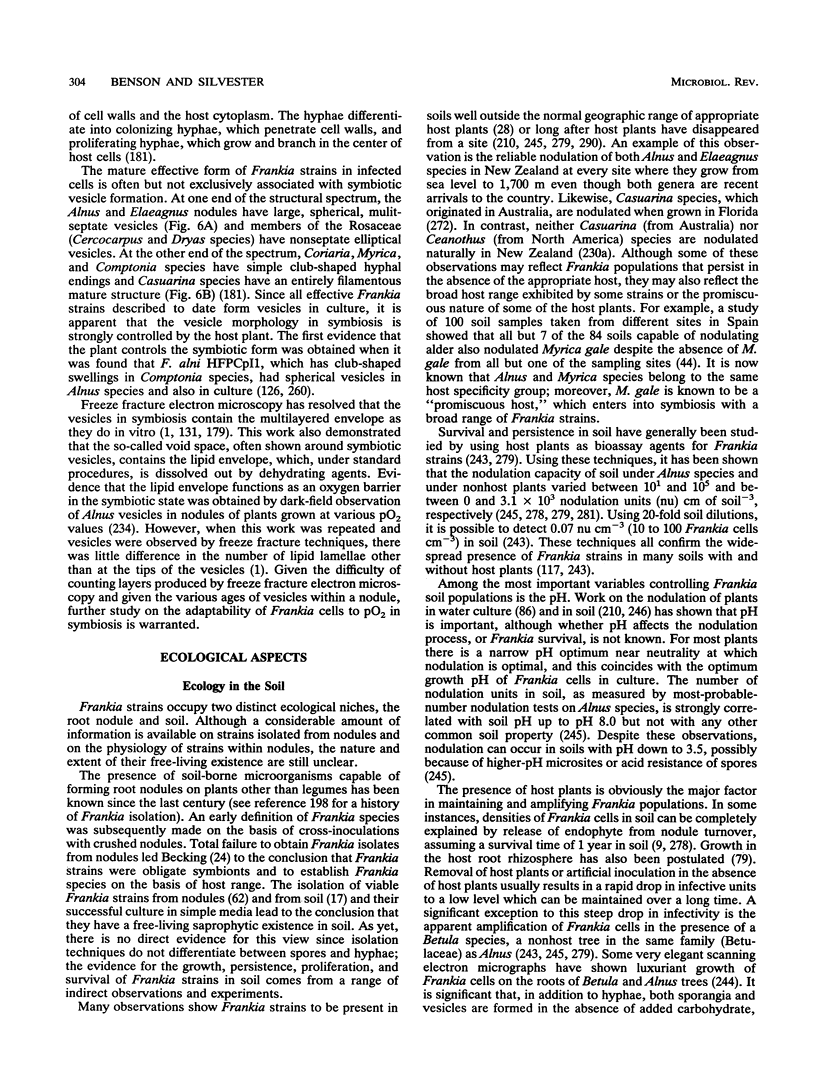
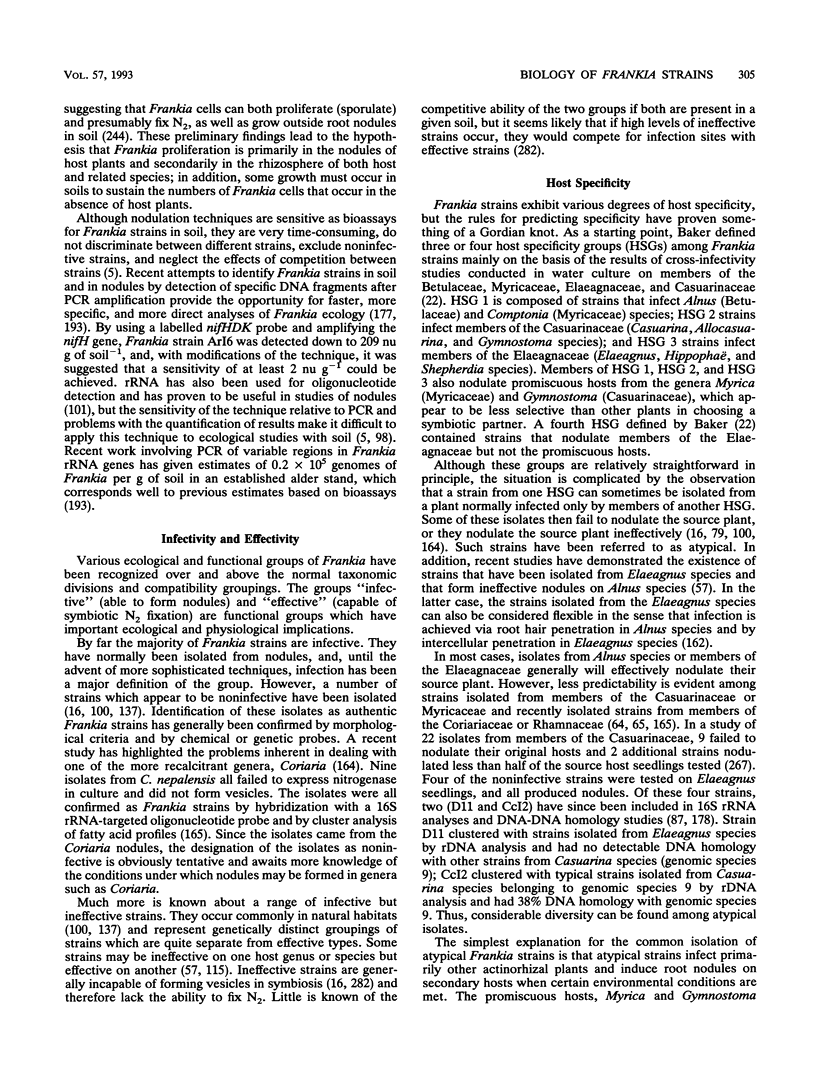
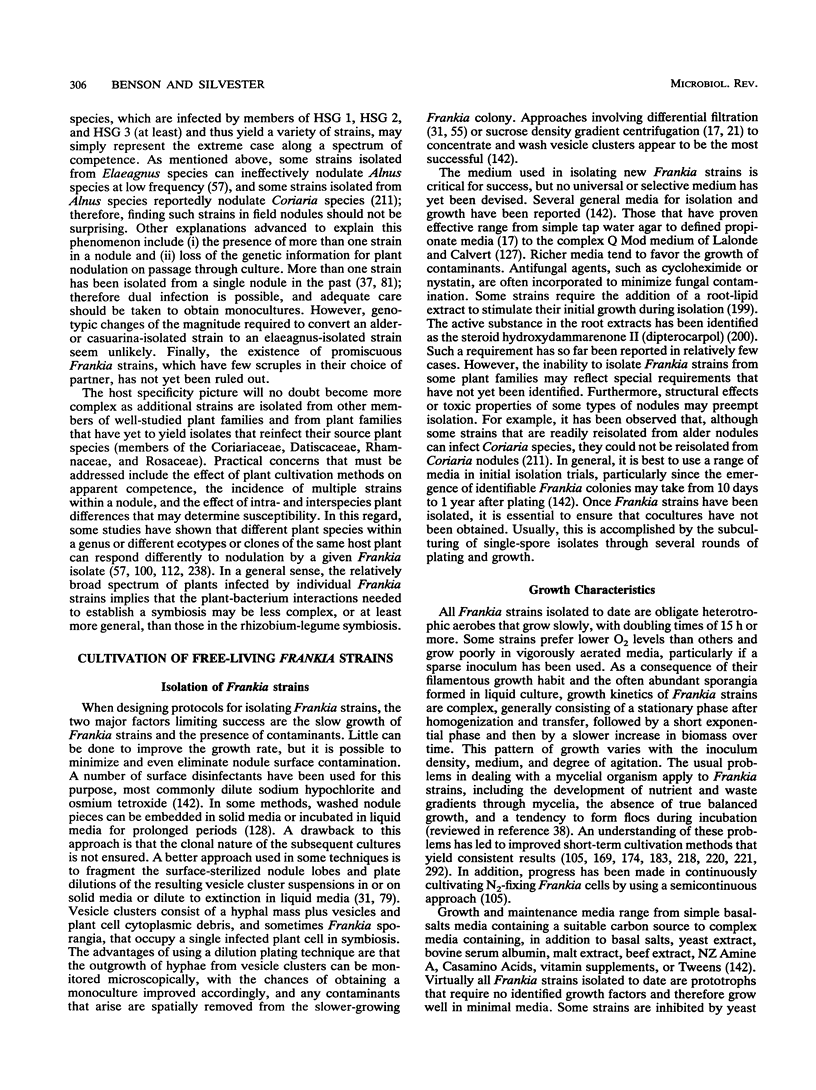

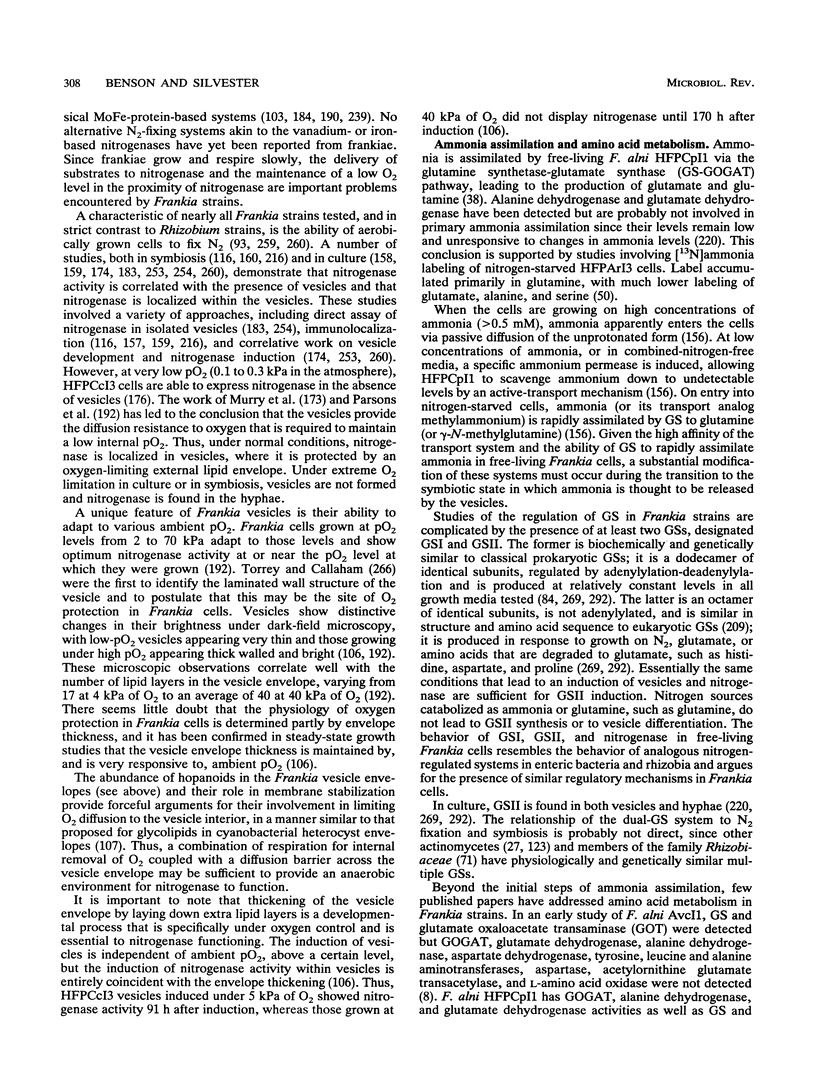
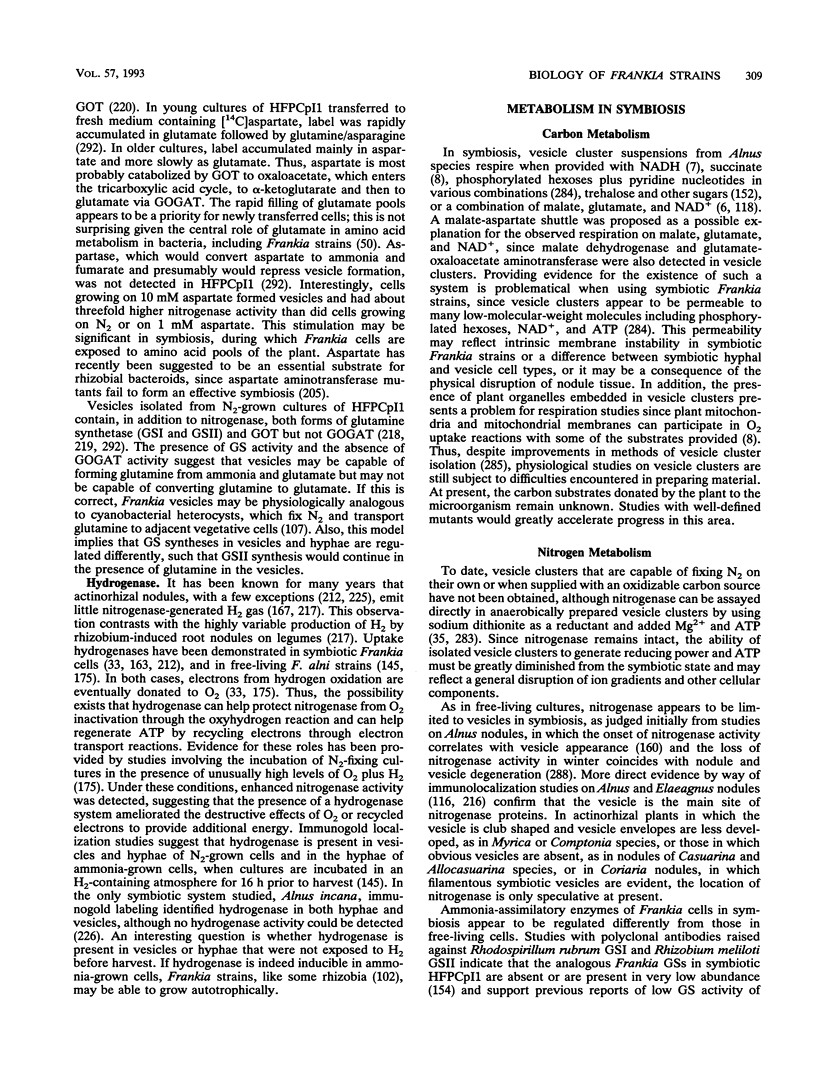
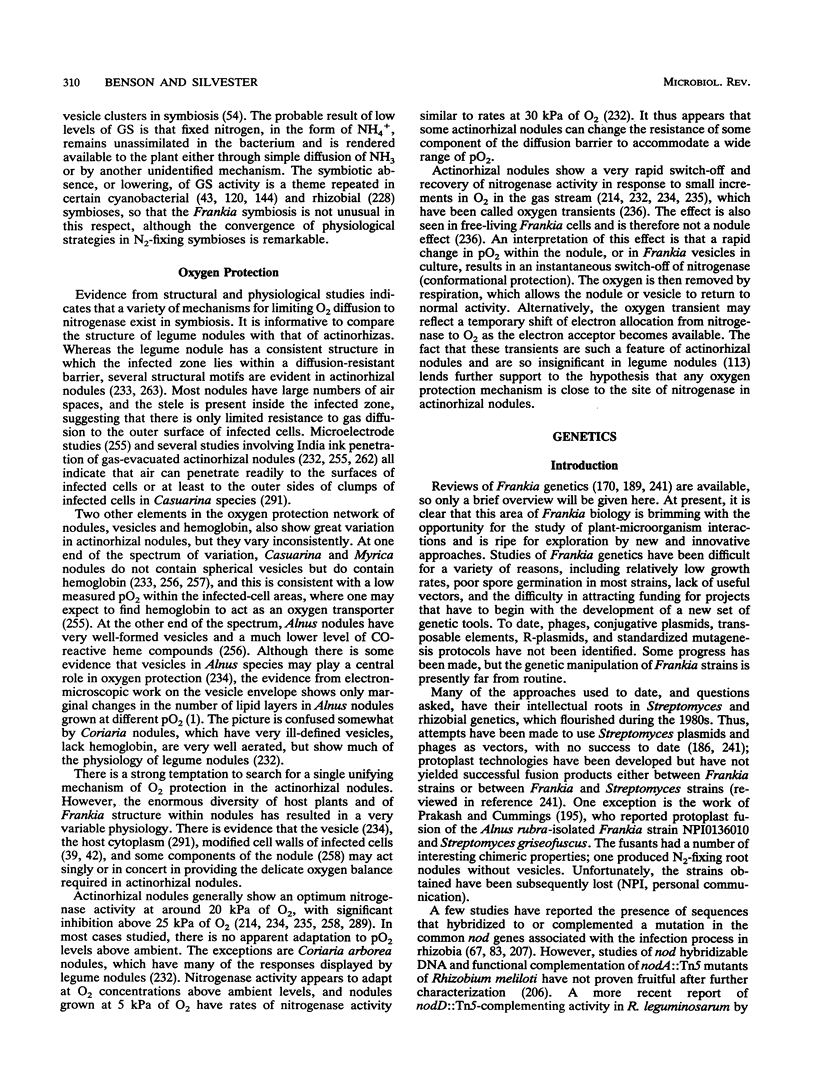
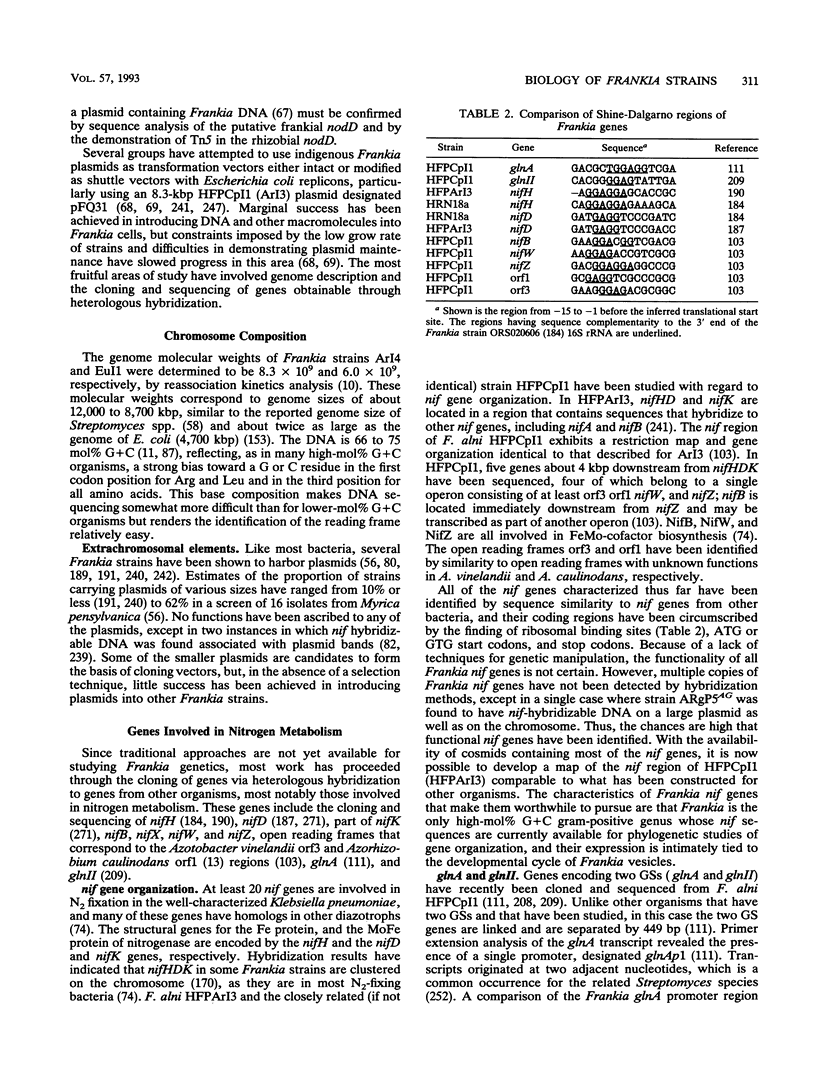
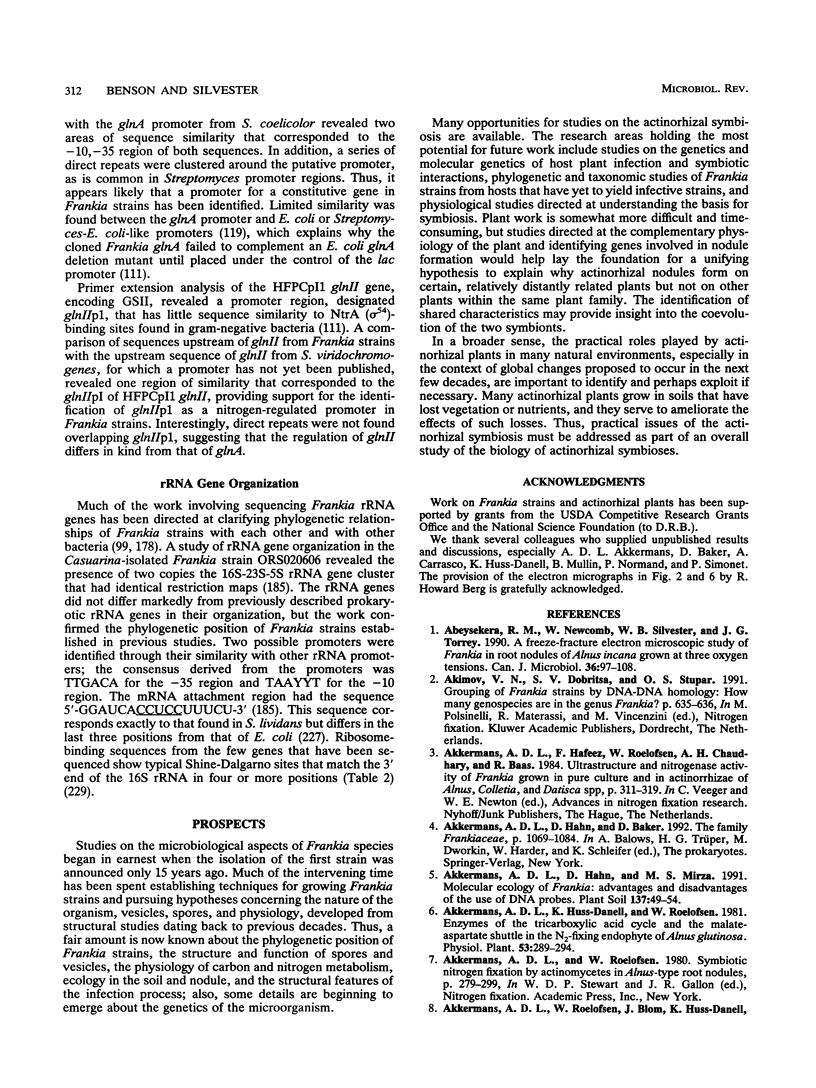
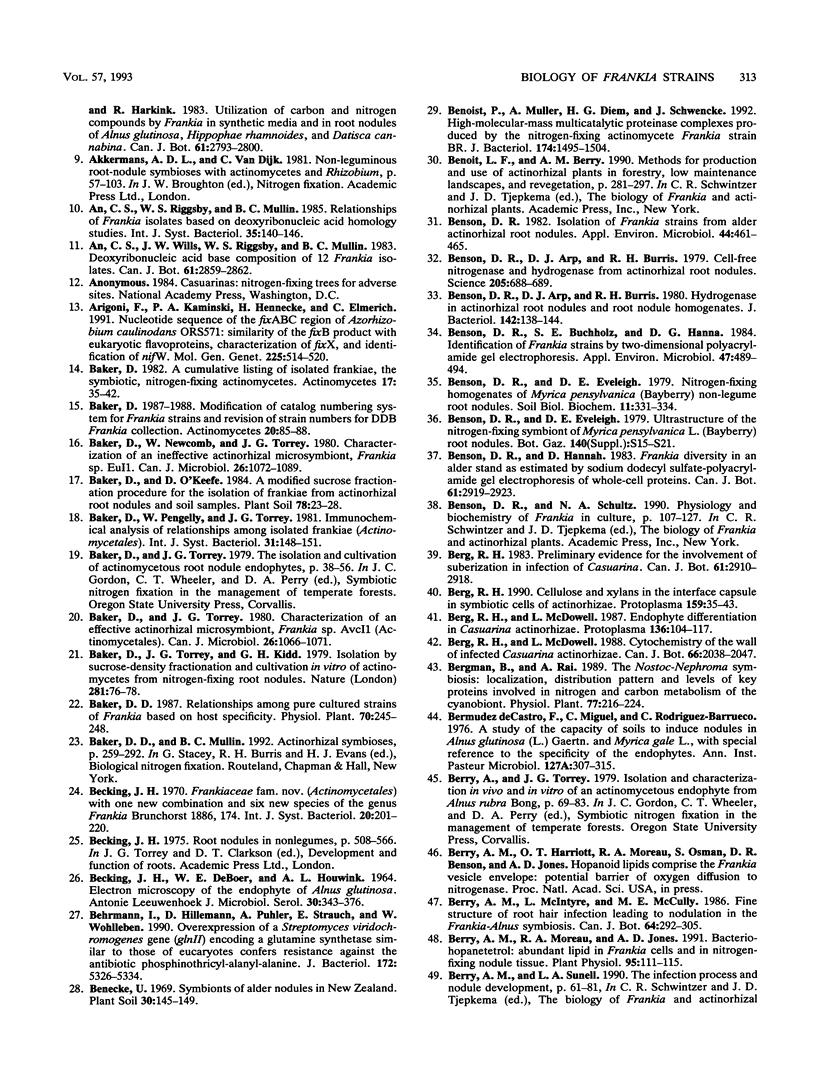
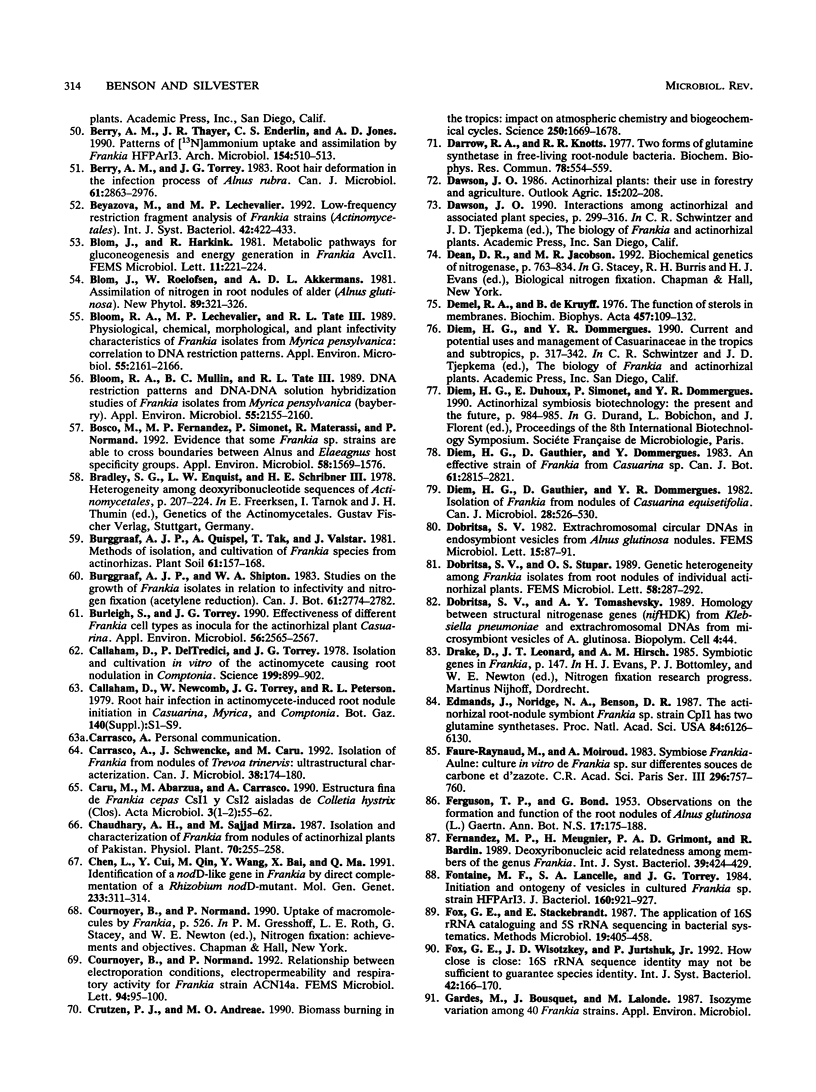
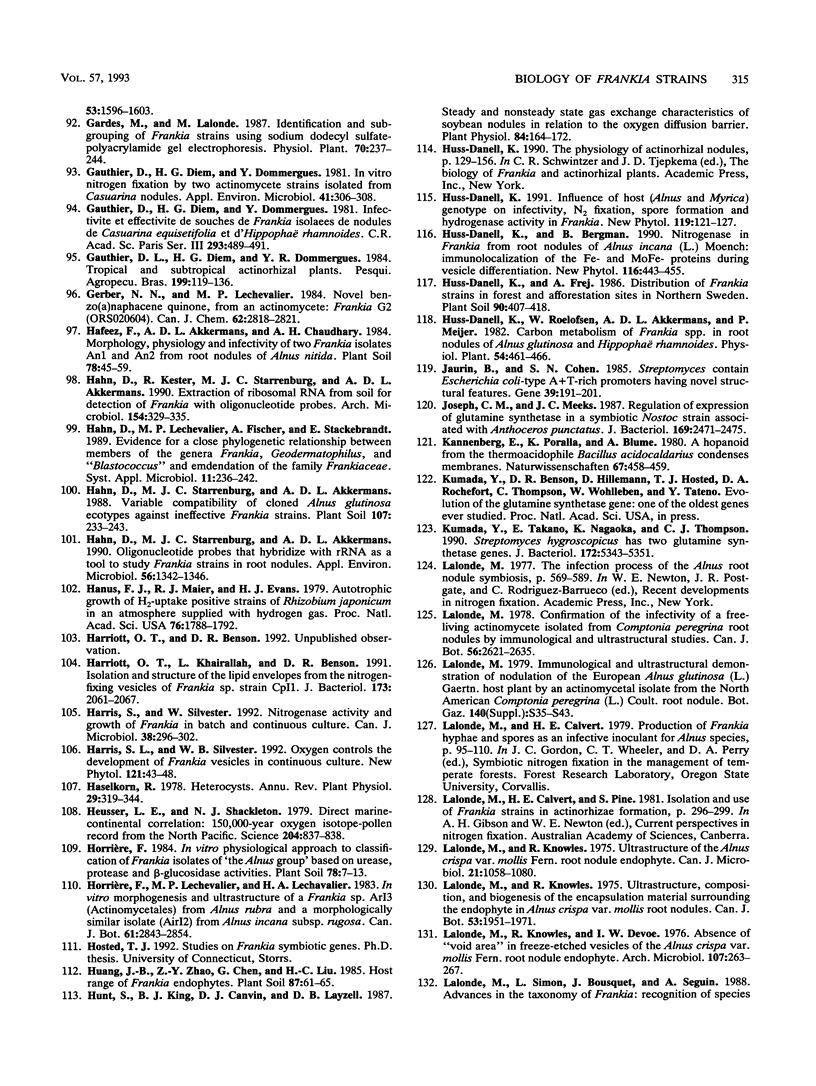
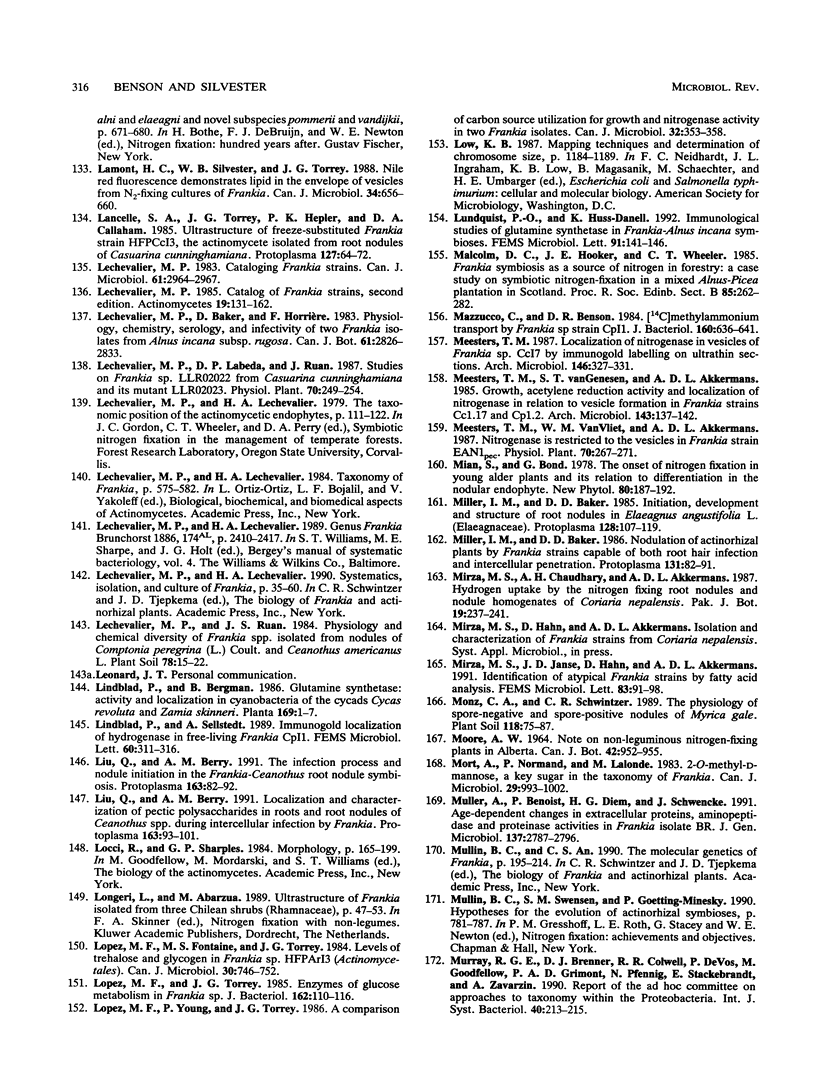
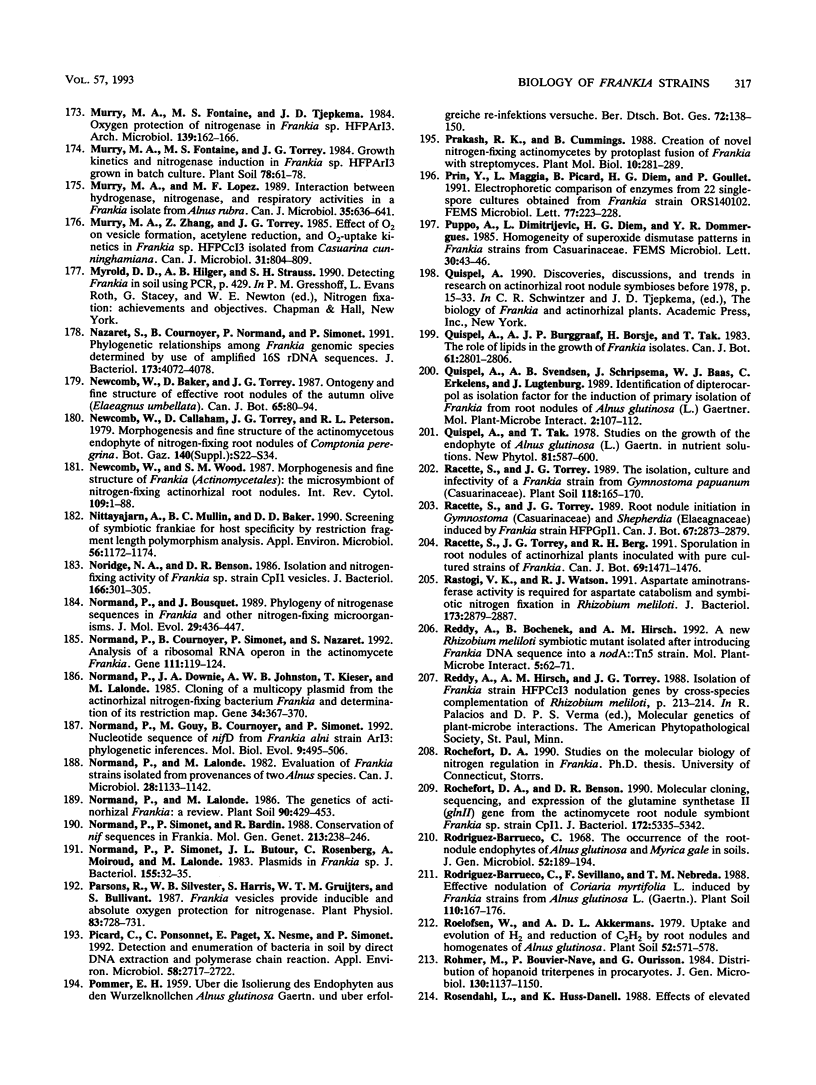
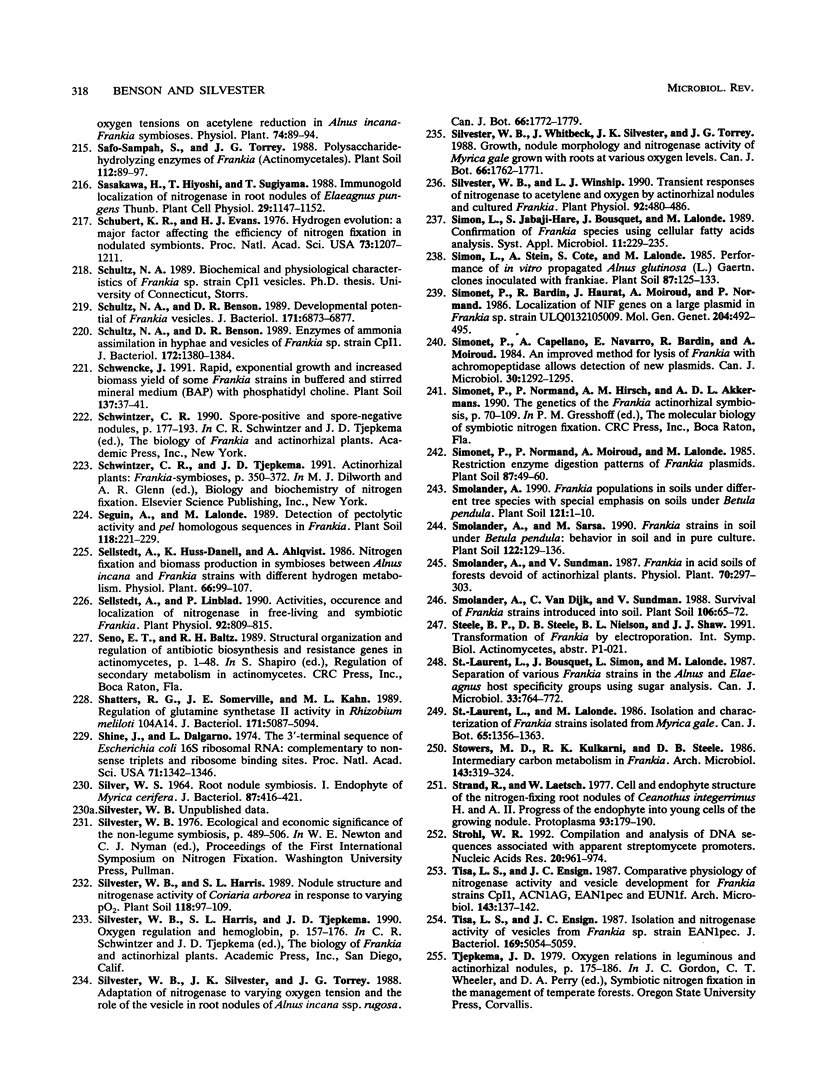
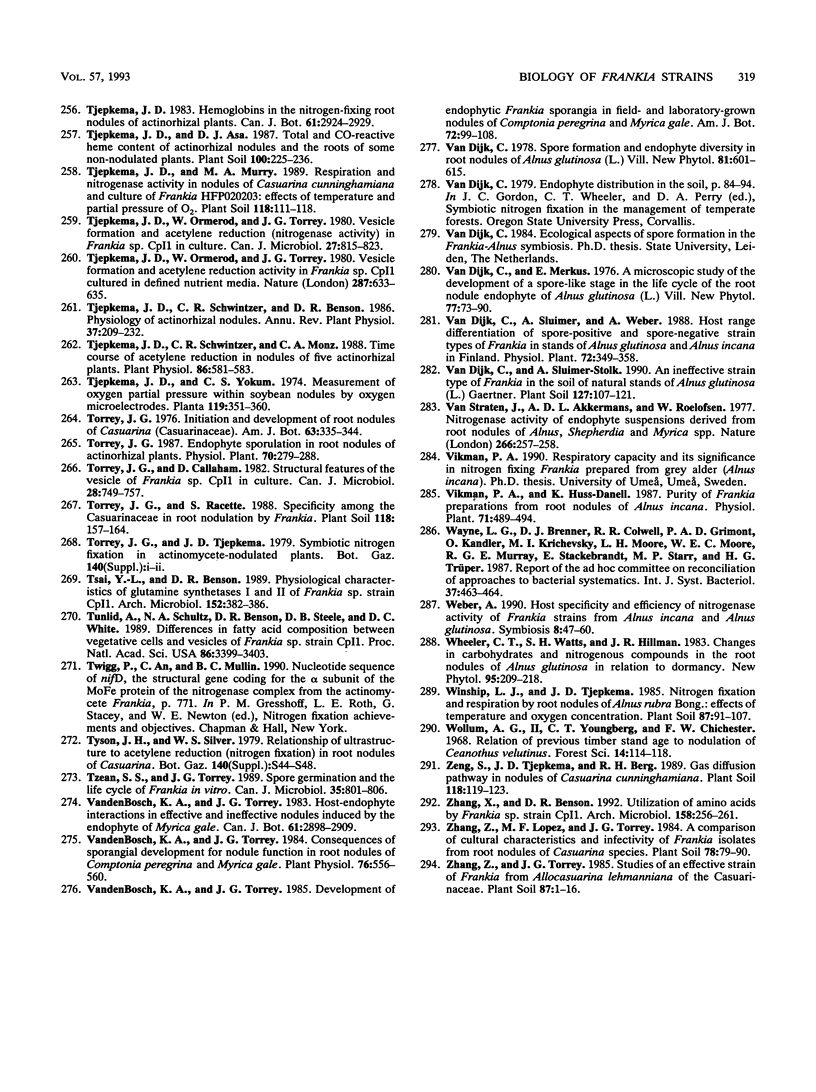
Images in this article
Selected References
These references are in PubMed. This may not be the complete list of references from this article.
- Arigoni F., Kaminski P. A., Hennecke H., Elmerich C. Nucleotide sequence of the fixABC region of Azorhizobium caulinodans ORS571: similarity of the fixB product with eukaryotic flavoproteins, characterization of fixX, and identification of nifW. Mol Gen Genet. 1991 Mar;225(3):514–520. doi: 10.1007/BF00261695. [DOI] [PubMed] [Google Scholar]
- BECKING J. H., DE BOER W. E., HOUWINK A. L. ELECTRON MICROSCOPY OF THE ENDOPHYTE OF ALNUS GLUTINOSA. Antonie Van Leeuwenhoek. 1964;30:343–376. doi: 10.1007/BF02046749. [DOI] [PubMed] [Google Scholar]
- Baker D., Newcomb W., Torrey J. G. Characterization of an ineffective actinorhizal microsymbiont, Frankia sp. EuI1 (Actinomycetales). Can J Microbiol. 1980 Sep;26(9):1072–1089. doi: 10.1139/m80-180. [DOI] [PubMed] [Google Scholar]
- Baker D., Torrey J. G. Characterization of an effective actinorhizal microsymbiont, Frankia sp. AvcI1 (Actinomycetales). Can J Microbiol. 1980 Sep;26(9):1066–1071. doi: 10.1139/m80-179. [DOI] [PubMed] [Google Scholar]
- Behrmann I., Hillemann D., Pühler A., Strauch E., Wohlleben W. Overexpression of a Streptomyces viridochromogenes gene (glnII) encoding a glutamine synthetase similar to those of eucaryotes confers resistance against the antibiotic phosphinothricyl-alanyl-alanine. J Bacteriol. 1990 Sep;172(9):5326–5334. doi: 10.1128/jb.172.9.5326-5334.1990. [DOI] [PMC free article] [PubMed] [Google Scholar]
- Benoist P., Müller A., Diem H. G., Schwencke J. High-molecular-mass multicatalytic proteinase complexes produced by the nitrogen-fixing actinomycete Frankia strain BR. J Bacteriol. 1992 Mar;174(5):1495–1504. doi: 10.1128/jb.174.5.1495-1504.1992. [DOI] [PMC free article] [PubMed] [Google Scholar]
- Benson D. R., Arp D. J., Burris R. H. Cell-free nitrogenase and hydrogenase from actinorhizal root nodules. Science. 1979 Aug 17;205(4407):688–689. doi: 10.1126/science.205.4407.688. [DOI] [PubMed] [Google Scholar]
- Benson D. R., Arp D. J., Burris R. H. Hydrogenase in actinorhizal root nodules and root nodule homogenates. J Bacteriol. 1980 Apr;142(1):138–144. doi: 10.1128/jb.142.1.138-144.1980. [DOI] [PMC free article] [PubMed] [Google Scholar]
- Benson D. R., Buchholz S. E., Hanna D. G. Identification of frankia strains by two-dimensional polyacrylamide gel electrophoresis. Appl Environ Microbiol. 1984 Mar;47(3):489–494. doi: 10.1128/aem.47.3.489-494.1984. [DOI] [PMC free article] [PubMed] [Google Scholar]
- Benson D. R. Isolation of frankia strains from alder actinorhizal root nodules. Appl Environ Microbiol. 1982 Aug;44(2):461–465. doi: 10.1128/aem.44.2.461-465.1982. [DOI] [PMC free article] [PubMed] [Google Scholar]
- Berry A. M., Moreau R. A., Jones A. D. Bacteriohopanetetrol: abundant lipid in frankia cells and in nitrogen-fixing nodule tissue. Plant Physiol. 1991 Jan;95(1):111–115. doi: 10.1104/pp.95.1.111. [DOI] [PMC free article] [PubMed] [Google Scholar]
- Beyazova M., Lechevalier M. P. Low-frequency restriction fragment analysis of Frankia strains (Actinomycetales). Int J Syst Bacteriol. 1992 Jul;42(3):422–433. doi: 10.1099/00207713-42-3-422. [DOI] [PubMed] [Google Scholar]
- Bloom R. A., Lechevalier M. P., Tate R. L., 3rd Physiological, chemical, morphological, and plant infectivity characteristics of Frankia isolates from Myrica pennsylvanica: correlation to DNA restriction patterns. Appl Environ Microbiol. 1989 Sep;55(9):2161–2166. doi: 10.1128/aem.55.9.2161-2166.1989. [DOI] [PMC free article] [PubMed] [Google Scholar]
- Bloom R. A., Mullin B. C., Tate R. L., 3rd DNA restriction patterns and DNA-DNA solution hybridization studies of Frankia isolates from Myrica pennsylvanica (bayberry). Appl Environ Microbiol. 1989 Sep;55(9):2155–2160. doi: 10.1128/aem.55.9.2155-2160.1989. [DOI] [PMC free article] [PubMed] [Google Scholar]
- Bosco M., Fernandez M. P., Simonet P., Materassi R., Normand P. Evidence that some Frankia sp. strains are able to cross boundaries between Alnus and Elaeagnus host specificity groups. Appl Environ Microbiol. 1992 May;58(5):1569–1576. doi: 10.1128/aem.58.5.1569-1576.1992. [DOI] [PMC free article] [PubMed] [Google Scholar]
- Burleigh Stephen, Torrey John G. Effectiveness of Different Frankia Cell Types as Inocula for the Actinorhizal Plant Casuarina. Appl Environ Microbiol. 1990 Aug;56(8):2565–2567. doi: 10.1128/aem.56.8.2565-2567.1990. [DOI] [PMC free article] [PubMed] [Google Scholar]
- Callaham D., Deltredici P., Torrey J. G. Isolation and Cultivation in vitro of the Actinomycete Causing Root Nodulation in Comptonia. Science. 1978 Feb 24;199(4331):899–902. doi: 10.1126/science.199.4331.899. [DOI] [PubMed] [Google Scholar]
- Chen L. M., Cui Y. H., Qin M., Wang Y. L., Bai X. L., Ma Q. S. Identification of a nodD-like gene in Frankia by direct complementation of a Rhizobium nodD-mutant. Mol Gen Genet. 1992 May;233(1-2):311–314. doi: 10.1007/BF00587593. [DOI] [PubMed] [Google Scholar]
- Cournoyer B., Normand P. Relationship between electroporation conditions, electropermeability and respiratory activity for Frankia strain ACN14a. FEMS Microbiol Lett. 1992 Jul 1;73(1-2):95–99. doi: 10.1016/0378-1097(92)90590-k. [DOI] [PubMed] [Google Scholar]
- Crutzen P. J., Andreae M. O. Biomass burning in the tropics: impact on atmospheric chemistry and biogeochemical cycles. Science. 1990 Dec 21;250(4988):1669–1678. doi: 10.1126/science.250.4988.1669. [DOI] [PubMed] [Google Scholar]
- Darrow R. A., Knotts R. R. Two forms of glutamine synthetase in free-living root-nodule bacteria. Biochem Biophys Res Commun. 1977 Sep 23;78(2):554–559. doi: 10.1016/0006-291x(77)90214-5. [DOI] [PubMed] [Google Scholar]
- Demel R. A., De Kruyff B. The function of sterols in membranes. Biochim Biophys Acta. 1976 Oct 26;457(2):109–132. doi: 10.1016/0304-4157(76)90008-3. [DOI] [PubMed] [Google Scholar]
- Edmands J., Noridge N. A., Benson D. R. The actinorhizal root-nodule symbiont Frankia sp. strain CpI1 has two glutamine synthetases. Proc Natl Acad Sci U S A. 1987 Sep;84(17):6126–6130. doi: 10.1073/pnas.84.17.6126. [DOI] [PMC free article] [PubMed] [Google Scholar]
- Fontaine M. S., Lancelle S. A., Torrey J. G. Initiation and ontogeny of vesicles in cultured Frankia sp. strain HFPArI3. J Bacteriol. 1984 Dec;160(3):921–927. doi: 10.1128/jb.160.3.921-927.1984. [DOI] [PMC free article] [PubMed] [Google Scholar]
- Fox G. E., Wisotzkey J. D., Jurtshuk P., Jr How close is close: 16S rRNA sequence identity may not be sufficient to guarantee species identity. Int J Syst Bacteriol. 1992 Jan;42(1):166–170. doi: 10.1099/00207713-42-1-166. [DOI] [PubMed] [Google Scholar]
- Gauthier D., Diem H. G., Dommergues Y. In vitro nitrogen fixation by two actinomycete strains isolated from casuarina nodules. Appl Environ Microbiol. 1981 Jan;41(1):306–308. doi: 10.1128/aem.41.1.306-308.1981. [DOI] [PMC free article] [PubMed] [Google Scholar]
- Hahn D., Kester R., Starrenburg M. J., Akkermans A. D. Extraction of ribosomal RNA from soil for detection of Frankia with oligonucleotide probes. Arch Microbiol. 1990;154(4):329–335. doi: 10.1007/BF00276527. [DOI] [PubMed] [Google Scholar]
- Hahn D., Starrenburg M. J., Akkermans A. D. Oligonucleotide Probes That Hybridize with rRNA as a Tool To Study Frankia Strains in Root Nodules. Appl Environ Microbiol. 1990 May;56(5):1342–1346. doi: 10.1128/aem.56.5.1342-1346.1990. [DOI] [PMC free article] [PubMed] [Google Scholar]
- Hanus F. J., Maier R. J., Evans H. J. Autotrophic growth of H2-uptake-positive strains of Rhizobium japonicum in an atmosphere supplied with hydrogen gas. Proc Natl Acad Sci U S A. 1979 Apr;76(4):1788–1792. doi: 10.1073/pnas.76.4.1788. [DOI] [PMC free article] [PubMed] [Google Scholar]
- Harriott O. T., Khairallah L., Benson D. R. Isolation and structure of the lipid envelopes from the nitrogen-fixing vesicles of Frankia sp. strain CpI1. J Bacteriol. 1991 Mar;173(6):2061–2067. doi: 10.1128/jb.173.6.2061-2067.1991. [DOI] [PMC free article] [PubMed] [Google Scholar]
- Harris S., Silvester W. Nitrogenase activity and growth of Frankia in batch and continuous culture. Can J Microbiol. 1992 Apr;38(4):296–302. doi: 10.1139/m92-049. [DOI] [PubMed] [Google Scholar]
- Heusser L. E., Shackleton N. J. Direct marine-continental correlation: 150,000-year oxygen isotope--pollen record from the north pacific. Science. 1979 May 25;204(4395):837–839. doi: 10.1126/science.204.4395.837. [DOI] [PubMed] [Google Scholar]
- Hunt S., King B. J., Canvin D. T., Layzell D. B. Steady and nonsteady state gas exchange characteristics of soybean nodules in relation to the oxygen diffusion barrier. Plant Physiol. 1987 May;84(1):164–172. doi: 10.1104/pp.84.1.164. [DOI] [PMC free article] [PubMed] [Google Scholar]
- Jaurin B., Cohen S. N. Streptomyces contain Escherichia coli-type A + T-rich promoters having novel structural features. Gene. 1985;39(2-3):191–201. doi: 10.1016/0378-1119(85)90313-0. [DOI] [PubMed] [Google Scholar]
- Joseph C. M., Meeks J. C. Regulation of expression of glutamine synthetase in a symbiotic Nostoc strain associated with Anthoceros punctatus. J Bacteriol. 1987 Jun;169(6):2471–2475. doi: 10.1128/jb.169.6.2471-2475.1987. [DOI] [PMC free article] [PubMed] [Google Scholar]
- Kumada Y., Takano E., Nagaoka K., Thompson C. J. Streptomyces hygroscopicus has two glutamine synthetase genes. J Bacteriol. 1990 Sep;172(9):5343–5351. doi: 10.1128/jb.172.9.5343-5351.1990. [DOI] [PMC free article] [PubMed] [Google Scholar]
- Lalonde M., Knowles R. Ultrastructure of the Alnus crispa var. mollis Fern. root nodule endophyte. Can J Microbiol. 1975 Jul;21(7):1058–1080. doi: 10.1139/m75-157. [DOI] [PubMed] [Google Scholar]
- Lopez M. F., Torrey J. G. Enzymes of glucose metabolism in Frankia sp. J Bacteriol. 1985 Apr;162(1):110–116. doi: 10.1128/jb.162.1.110-116.1985. [DOI] [PMC free article] [PubMed] [Google Scholar]
- Mazzucco C. E., Benson D. R. [14C]methylammonium transport by Frankia sp. strain CpI1. J Bacteriol. 1984 Nov;160(2):636–641. doi: 10.1128/jb.160.2.636-641.1984. [DOI] [PMC free article] [PubMed] [Google Scholar]
- Murry M. A., Fontaine M. S., Tjepkema J. D. Oxygen protection of nitrogenase in Frankia sp. HFPArI3. Arch Microbiol. 1984 Oct;139(2-3):162–166. doi: 10.1007/BF00401993. [DOI] [PubMed] [Google Scholar]
- Murry M. A., Lopez M. F. Interaction between hydrogenase, nitrogenase, and respiratory activities in a Frankia isolate from Alnus rubra. Can J Microbiol. 1989 Jun;35(6):636–641. doi: 10.1139/m89-102. [DOI] [PubMed] [Google Scholar]
- Murry M. A., Zhongze Z., Torrey J. G. Effect of O2 on vesicle formation, acetylene reduction, and O2-uptake kinetics in Frankia sp. HFPCcI3 isolated from Casuarina cunninghamiana. Can J Microbiol. 1985 Sep;31(9):804–809. doi: 10.1139/m85-151. [DOI] [PubMed] [Google Scholar]
- Müller A., Benoist P., Diem H. G., Schwencke J. Age-dependent changes in extracellular proteins, aminopeptidase and proteinase activities in Frankia isolate BR. J Gen Microbiol. 1991 Dec;137(12):2787–2796. doi: 10.1099/00221287-137-12-2787. [DOI] [PubMed] [Google Scholar]
- Nazaret S., Cournoyer B., Normand P., Simonet P. Phylogenetic relationships among Frankia genomic species determined by use of amplified 16S rDNA sequences. J Bacteriol. 1991 Jul;173(13):4072–4078. doi: 10.1128/jb.173.13.4072-4078.1991. [DOI] [PMC free article] [PubMed] [Google Scholar]
- Newcomb W., Wood S. M. Morphogenesis and fine structure of Frankia (Actinomycetales): the microsymbiont of nitrogen-fixing actinorhizal root nodules. Int Rev Cytol. 1987;109:1–88. doi: 10.1016/s0074-7696(08)61719-2. [DOI] [PubMed] [Google Scholar]
- Nittayajarn A., Mullin B. C., Baker D. D. Screening of symbiotic frankiae for host specificity by restriction fragment length polymorphism analysis. Appl Environ Microbiol. 1990 Apr;56(4):1172–1174. doi: 10.1128/aem.56.4.1172-1174.1990. [DOI] [PMC free article] [PubMed] [Google Scholar]
- Noridge N. A., Benson D. R. Isolation and nitrogen-fixing activity of Frankia sp. strain CpI1 vesicles. J Bacteriol. 1986 Apr;166(1):301–305. doi: 10.1128/jb.166.1.301-305.1986. [DOI] [PMC free article] [PubMed] [Google Scholar]
- Normand P., Bousquet J. Phylogeny of nitrogenase sequences in Frankia and other nitrogen-fixing microorganisms. J Mol Evol. 1989 Nov;29(5):436–447. doi: 10.1007/BF02602914. [DOI] [PubMed] [Google Scholar]
- Normand P., Cournoyer B., Simonet P., Nazaret S. Analysis of a ribosomal RNA operon in the actinomycete Frankia. Gene. 1992 Feb 1;111(1):119–124. doi: 10.1016/0378-1119(92)90612-s. [DOI] [PubMed] [Google Scholar]
- Normand P., Downie J. A., Johnston A. W., Kieser T., Lalonde M. Cloning of a multicopy plasmid from the actinorhizad nitrogen-fixing bacterium Frankia sp. and determination of its restriction map. Gene. 1985;34(2-3):367–370. doi: 10.1016/0378-1119(85)90147-7. [DOI] [PubMed] [Google Scholar]
- Normand P., Gouy M., Cournoyer B., Simonet P. Nucleotide sequence of nifD from Frankia alni strain ArI3: phylogenetic inferences. Mol Biol Evol. 1992 May;9(3):495–506. doi: 10.1093/oxfordjournals.molbev.a040737. [DOI] [PubMed] [Google Scholar]
- Normand P., Simonet P., Bardin R. Conservation of nif sequences in Frankia. Mol Gen Genet. 1988 Aug;213(2-3):238–246. doi: 10.1007/BF00339587. [DOI] [PubMed] [Google Scholar]
- Normand P., Simonet P., Butour J. L., Rosenberg C., Moiroud A., Lalonde M. Plasmids in Frankia sp. J Bacteriol. 1983 Jul;155(1):32–35. doi: 10.1128/jb.155.1.32-35.1983. [DOI] [PMC free article] [PubMed] [Google Scholar]
- Parsons R., Silvester W. B., Harris S., Gruijters W. T., Bullivant S. Frankia vesicles provide inducible and absolute oxygen protection for nitrogenase. Plant Physiol. 1987 Apr;83(4):728–731. doi: 10.1104/pp.83.4.728. [DOI] [PMC free article] [PubMed] [Google Scholar]
- Picard C., Ponsonnet C., Paget E., Nesme X., Simonet P. Detection and enumeration of bacteria in soil by direct DNA extraction and polymerase chain reaction. Appl Environ Microbiol. 1992 Sep;58(9):2717–2722. doi: 10.1128/aem.58.9.2717-2722.1992. [DOI] [PMC free article] [PubMed] [Google Scholar]
- Rastogi V. K., Watson R. J. Aspartate aminotransferase activity is required for aspartate catabolism and symbiotic nitrogen fixation in Rhizobium meliloti. J Bacteriol. 1991 May;173(9):2879–2887. doi: 10.1128/jb.173.9.2879-2887.1991. [DOI] [PMC free article] [PubMed] [Google Scholar]
- Rochefort D. A., Benson D. R. Molecular cloning, sequencing, and expression of the glutamine synthetase II (glnII) gene from the actinomycete root nodule symbiont Frankia sp. strain CpI1. J Bacteriol. 1990 Sep;172(9):5335–5342. doi: 10.1128/jb.172.9.5335-5342.1990. [DOI] [PMC free article] [PubMed] [Google Scholar]
- SILVER W. S. ROOT NODULE SYMBIOSIS. I. ENDOPHYTE OF MYRICA CERIFERA L. J Bacteriol. 1964 Feb;87:416–421. doi: 10.1128/jb.87.2.416-421.1964. [DOI] [PMC free article] [PubMed] [Google Scholar]
- Schubert K. R., Evans H. J. Hydrogen evolution: A major factor affecting the efficiency of nitrogen fixation in nodulated symbionts. Proc Natl Acad Sci U S A. 1976 Apr;73(4):1207–1211. doi: 10.1073/pnas.73.4.1207. [DOI] [PMC free article] [PubMed] [Google Scholar]
- Schultz N. A., Benson D. R. Developmental potential of Frankia vesicles. J Bacteriol. 1989 Dec;171(12):6873–6877. doi: 10.1128/jb.171.12.6873-6877.1989. [DOI] [PMC free article] [PubMed] [Google Scholar]
- Schultz N. A., Benson D. R. Enzymes of ammonia assimilation in hyphae and vesicles of Frankia sp. strain CpI1. J Bacteriol. 1990 Mar;172(3):1380–1384. doi: 10.1128/jb.172.3.1380-1384.1990. [DOI] [PMC free article] [PubMed] [Google Scholar]
- Sellstedt A., Lindblad P. Activities, occurrence, and localization of hydrogenase in free-living and symbiotic frankia. Plant Physiol. 1990 Mar;92(3):809–815. doi: 10.1104/pp.92.3.809. [DOI] [PMC free article] [PubMed] [Google Scholar]
- Shatters R. G., Somerville J. E., Kahn M. L. Regulation of glutamine synthetase II activity in Rhizobium meliloti 104A14. J Bacteriol. 1989 Sep;171(9):5087–5094. doi: 10.1128/jb.171.9.5087-5094.1989. [DOI] [PMC free article] [PubMed] [Google Scholar]
- Shine J., Dalgarno L. The 3'-terminal sequence of Escherichia coli 16S ribosomal RNA: complementarity to nonsense triplets and ribosome binding sites. Proc Natl Acad Sci U S A. 1974 Apr;71(4):1342–1346. doi: 10.1073/pnas.71.4.1342. [DOI] [PMC free article] [PubMed] [Google Scholar]
- Silvester W. B., Winship L. J. Transient responses of nitrogenase to acetylene and oxygen in actinorhizal nodules and cultured frankia. Plant Physiol. 1990 Feb;92(2):480–486. doi: 10.1104/pp.92.2.480. [DOI] [PMC free article] [PubMed] [Google Scholar]
- Strohl W. R. Compilation and analysis of DNA sequences associated with apparent streptomycete promoters. Nucleic Acids Res. 1992 Mar 11;20(5):961–974. doi: 10.1093/nar/20.5.961. [DOI] [PMC free article] [PubMed] [Google Scholar]
- Tisa L. S., Ensign J. C. Isolation and nitrogenase activity of vesicles from Frankia sp. strain EAN1pec. J Bacteriol. 1987 Nov;169(11):5054–5059. doi: 10.1128/jb.169.11.5054-5059.1987. [DOI] [PMC free article] [PubMed] [Google Scholar]
- Tjepkema J. D., Ormerod W., Torrey J. G. Factors affecting vesicle formation and acetylene reduction (nitrogenase activity) in Frankia sp. CpI1. Can J Microbiol. 1981 Aug;27(8):815–823. doi: 10.1139/m81-126. [DOI] [PubMed] [Google Scholar]
- Tjepkema J. D., Schwintzer C. R., Monz C. A. Time course of acetylene reduction in nodules of five actinorhizal genera. Plant Physiol. 1988 Feb;86(2):581–583. doi: 10.1104/pp.86.2.581. [DOI] [PMC free article] [PubMed] [Google Scholar]
- Tunlid A., Schultz N. A., Benson D. R., Steele D. B., White D. C. Differences in fatty acid composition between vegetative cells and N(2)-fixing vesicles of Frankia sp. strain CpI1. Proc Natl Acad Sci U S A. 1989 May;86(9):3399–3403. doi: 10.1073/pnas.86.9.3399. [DOI] [PMC free article] [PubMed] [Google Scholar]
- Vandenbosch K. A., Torrey J. G. Consequences of Sporangial Development for Nodule Function in Root Nodules of Comptonia peregrina and Myrica gale. Plant Physiol. 1984 Nov;76(3):556–560. doi: 10.1104/pp.76.3.556. [DOI] [PMC free article] [PubMed] [Google Scholar]
- de Castro F. B., Miguel C., Rodriguez-Barrueco C. A study of the capacity of soils to induce nodules in Alnus glutinosa (L.) Gaertn. and Myrica gale L., with special reference to the specificity of the endophytes. Ann Microbiol (Paris) 1976 Feb-Mar;127A(2):307–315. [PubMed] [Google Scholar]



